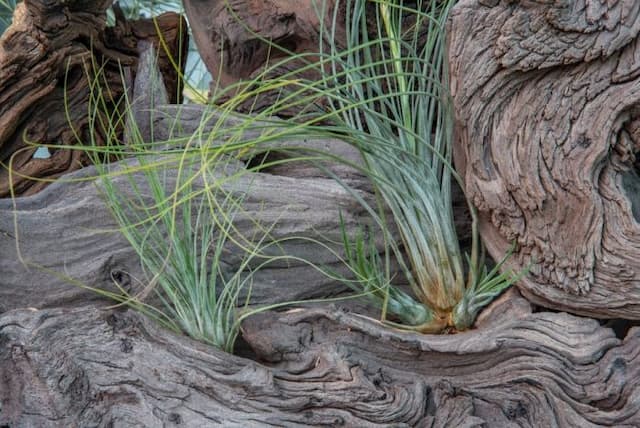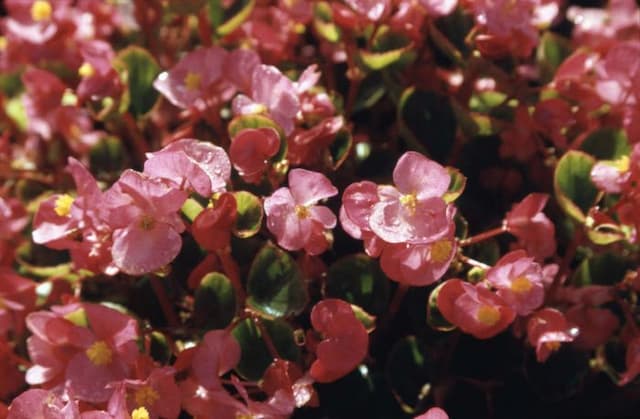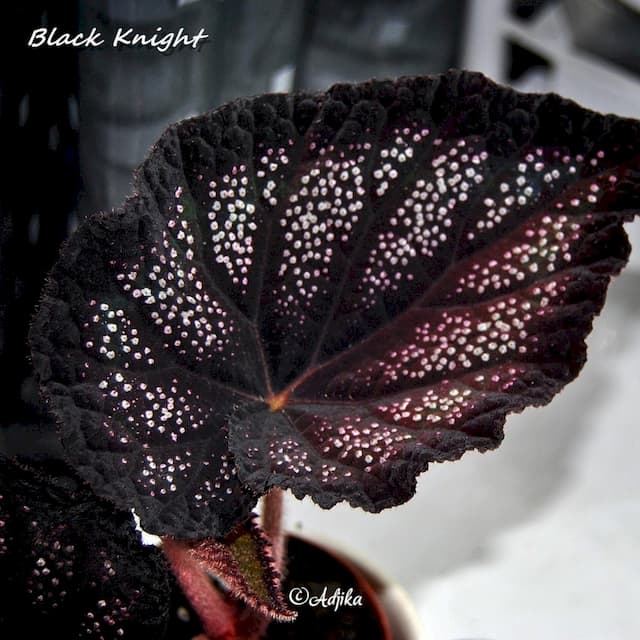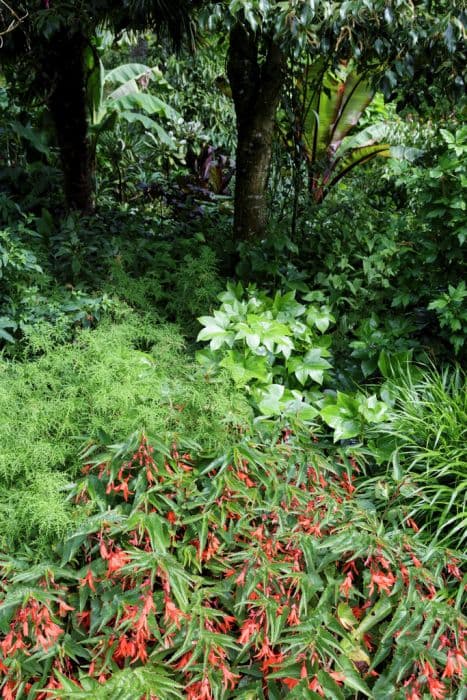Wax Begonia Begonia 'Martin Johnson' (R)

ABOUT
Begonia 'Martin Johnson' is a stunning ornamental plant known for its distinctive foliage and blossoms. The leaves are a standout feature, boasting a bold green color with a unique pattern that may vary from leaf to leaf. The texture of the leaves is typically lush and somewhat waxy to the touch, contributing to the plant's robust appearance. The flowers of Begonia 'Martin Johnson' are equally impressive, presenting in vibrant hues that can range from delicate pinks to rich, intense reds or oranges. These blossoms are typically small to medium in size and grow in clusters, which adds to the plant's decorative appeal. Flowers might be present throughout various seasons, depending on the specific growing conditions and care the plant receives. Overall, Begonia 'Martin Johnson' presents a full and bushy appearance that makes it a favorite among gardeners and houseplant enthusiasts alike. Its striking leaves and charming flowers create a visual spectacle that can enhance the aesthetic of any garden space or indoor area where it is displayed.
About this plant
 Names
NamesSynonyms
Martin Johnson Begonia, Rieger Begonia
Common names
Begonia 'Martin Johnson'
 Toxicity
ToxicityTo humans
Begonia, including the Begonia 'Martin Johnson', is considered non-toxic to humans. While it is generally safe, ingestion can cause mild irritation in the mouth, throat, and may cause nausea or vomiting in some individuals due to the presence of insoluble oxalates.
To pets
Begonia, including the Begonia 'Martin Johnson', is toxic to pets such as dogs and cats. If ingested, it can cause oral irritation, drooling, vomiting, and difficulty swallowing. The insoluble oxalates found in the plant can result in these symptoms. If a pet has ingested begonia, it is advisable to contact a veterinarian.
 Characteristics
CharacteristicsLife cycle
Perennials
Foliage type
Evergreen
Color of leaves
Varied
Flower color
Pink
Height
1-2 feet (30-60 cm)
Spread
1-2 feet (30-60 cm)
Plant type
Herb
Hardiness zones
10
Native area
Central America
Benefits
 General Benefits
General Benefits- Aesthetic Appeal: Adds vibrant color and texture to gardens or indoor spaces with its attractive foliage and flowers.
- Easy to Care For: Requires minimal maintenance, making it suitable for gardeners of all skill levels.
- Versatility: Can be grown in a variety of settings, including containers, hanging baskets, or garden beds.
- Long Blooming Season: Produces flowers for an extended period, often from spring to fall, providing long-lasting visual interest.
- Attracts Pollinators: Flowers can attract beneficial insects like bees and butterflies to the garden, supporting local ecosystems.
- Compact Growth: Suitable for small spaces due to its compact size, it can thrive in limited space environments like apartments and balconies.
 Medical Properties
Medical PropertiesThis plant is not used for medical purposes.
 Air-purifying Qualities
Air-purifying QualitiesThis plant is not specifically known for air purifying qualities.
 Other Uses
Other Uses- Photography subject - The vibrant colors and patterns of Begonia 'Martin Johnson' make it a popular choice for floral photographers and enthusiasts seeking to capture the beauty of unique plant specimens.
- Art inspiration - Artists may draw inspiration from the intricate patterns and hues of the leaves for their paintings, drawings, or textile designs.
- Educational model - This plant can be used in biology classes to teach about hybridization, plant genetics, and the diversity of leaf forms in the plant kingdom.
- Floral arrangements - Although not commonly used, the leaves can add an exotic touch to floral arrangements when combined with other flowers and foliage.
- Terrariums - Begonia 'Martin Johnson' can be featured as a striking centerpiece in a terrarium, offering visual interest with its foliage.
- Wedding decor - The plant's leaves can be incorporated into wedding decor, offering a lush, green backdrop or as part of table centerpieces.
- Fashion design - The unique appearance of Begonia 'Martin Johnson' can inspire patterns and motifs in fashion design for clothes and accessories.
- Botanical illustration - The distinct look of this begonia is perfect for botanical illustrators who wish to capture the diversity of plant life in their work.
- Crafting - Leaves and flowers can be used in various crafting activities, like making printed patterns on fabrics or paper.
- Color palettes - Interior designers and decorators may use the plant as inspiration for developing color schemes for rooms and spaces.
Interesting Facts
 Feng Shui
Feng ShuiThe Begonia is not used in Feng Shui practice.
 Zodiac Sign Compitability
Zodiac Sign CompitabilityThe Begonia is not used in astrology practice.
 Plant Symbolism
Plant Symbolism- Caution: In the language of flowers, begonia often represents caution or a warning to be careful, suggesting that one should think twice before proceeding in a given situation.
- Deep Thoughts: Featuring complex, intricate blooms, begonias can symbolize deep thought or contemplation.
- Unconventional Spirit: Begonias are unique in their appearance and have come to represent individuality and an unconventional spirit.
- Friendship: Some believe begonias can stand for friendship and deep affection, as they are commonly gifted to friends and loved ones.
- Harmony: The symmetry and balance often found in begonia flowers can symbolize harmony and balance in one's life.
 Water
WaterThe Begonia 'Martin Johnson,' also known as Martin Johnson Begonia, should be watered thoroughly when the top inch of soil feels dry to the touch. This typically means watering once every 7 to 10 days, but the frequency may need to be adjusted based on the humidity and temperature of your home. When watering, it is important to gently pour water until it begins to run out of the bottom of the pot, ensuring the root system is adequately saturated. Use room temperature water to avoid shocking the plant. Typically, using about 8 to 16 ounces of water per plant should be sufficient, but always check the soil moisture before adding more water.
 Light
LightThe Martin Johnson Begonia thrives in bright, indirect light. It is best situated in a spot where it will receive plenty of light without being exposed to direct sunlight, which can scorch the leaves. An east or west-facing window with sheer curtains to diffuse the light is ideal for this plant.
 Temperature
TemperatureThe Martin Johnson Begonia prefers temperatures between 60 and 75 degrees Fahrenheit. It can survive a minimum temperature of about 50 degrees Fahrenheit, and a maximum of around 85 degrees Fahrenheit. The ideal temperature range creates a comfortable environment for the plant to thrive in typical indoor conditions.
 Pruning
PruningPrune the Martin Johnson Begonia to maintain its shape and encourage bushier growth. This should be done as needed when you notice any dead or yellowing leaves. Light pruning can be done at any time, but more extensive pruning is best done in the spring before new growth begins. Pinch off the tips of the stems to promote fuller growth.
 Cleaning
CleaningAs needed
 Soil
SoilBegonia 'Martin Johnson' prefers a well-draining soil mix with equal parts peat, pine bark, and perlite or sand to promote aeration and prevent waterlogging. The ideal soil pH for this Begonia should be mildly acidic to neutral, ranging from about 5.5 to 6.5.
 Repotting
RepottingBegonia 'Martin Johnson' typically requires repotting every 1-2 years or whenever it outgrows its current pot. It's best to repot in spring or early summer to allow the plant to recover during its active growing period.
 Humidity & Misting
Humidity & MistingBegonia 'Martin Johnson' thrives in high humidity conditions, ideally between 60% to 70%. It is important to maintain consistent humidity without fluctuation to ensure the health and growth of the plant.
 Suitable locations
Suitable locationsIndoor
Place in bright, indirect light with high humidity.
Outdoor
Shelter from direct sun, protect from frost, high humidity.
Hardiness zone
10-11 USDA
 Life cycle
Life cycleBegonia 'Martin Johnson' starts its life cycle with seed germination, where the seeds require warmth and moisture to sprout. Once established, the seedlings grow into juvenile plants, developing characteristic asymmetrical leaves and branching stems in a vegetative stage. As the plants mature, they enter a phase of flowering where they produce distinctive flowers, often attracting pollinators if outdoors. Following pollination, the flowers develop into seed capsules, which upon drying, release seeds, thus completing the reproductive cycle. In optimal conditions, Begonia 'Martin Johnson' may also propagate asexually through leaf or stem cuttings, which root to form new plants. The mature plants then enter a period of senescence and die back, especially if exposed to temperatures below their tolerance, yet they can regrow if the tuberous rootstock is protected or brought indoors.
 Propogation
PropogationPropogation time
Spring-Early Summer
The Begonia 'Martin Johnson', commonly known as Begonia, can be propagated effectively through leaf cuttings, which is the most popular method for this plant. To propagate by leaf cuttings, select a healthy, mature leaf and cut it into pieces, each with at least one vein. Lay the leaf pieces vein-side down on moistened potting mix in a tray. Cover the tray with plastic to create a greenhouse effect, keeping the humidity high, which is essential for rooting. Place the tray in bright, indirect light and maintain the soil moisture without soaking it. Roots and new shoots will typically begin to form in a few weeks, at which point the new plantlets can be potted separately. This propagation is usually done during the spring or early summer months when the plant is actively growing and can recover quickly from the loss of leaf material.

![Begonia [Allure]](/_next/image?url=https%3A%2F%2Fplants-admin.emdemapps.com%2Fimages%2Fplants%2F%2Fimages%2F604b5b9006ab9.png&w=640&q=75)







